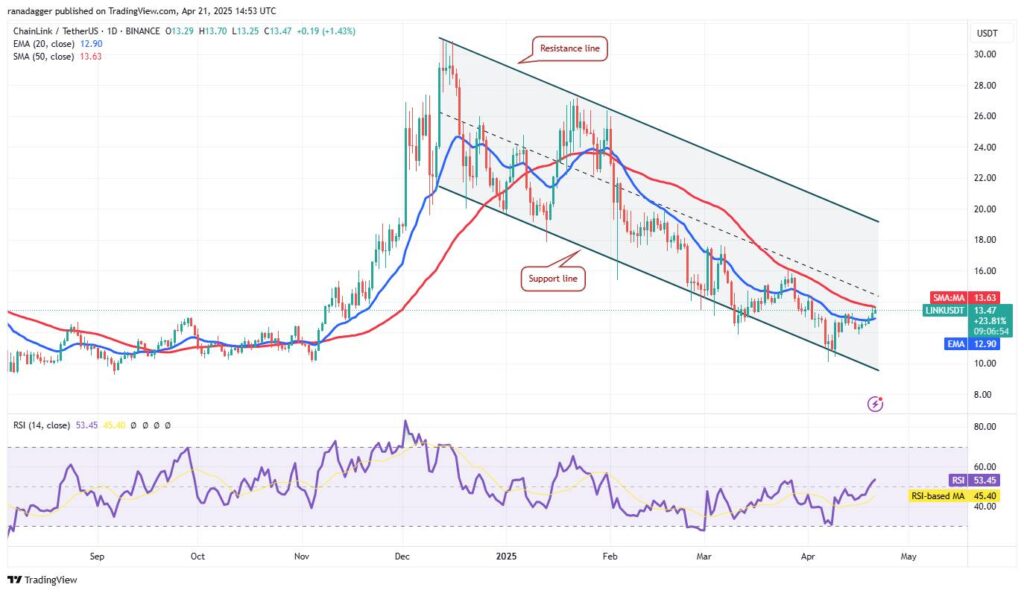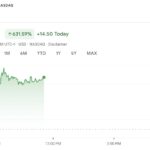In a striking turn of events on April 21, the US Dollar Index (DXY) dropped below the crucial 98 mark, marking its lowest point in three years. This significant decline has led to a surge in gold prices, pushing it to a historic high. The impact was also felt across the cryptocurrency landscape, with Bitcoin (BTC) rising impressively above the $88,000 threshold. Arthur Hayes, co-founder of BitMEX and chief investment officer at Maelstrom, has suggested that this might be the final opportunity for investors to acquire Bitcoin for under $100,000, amid speculation that the Federal Reserve could soon initiate US Treasury buybacks to support Bitcoin’s price trajectory.
“The whales seem ready for the move higher, as they have been accumulating in March and April,” stated analysts following the latest trends. According to data from Glassnode, the number of wallets holding over 1,000 Bitcoin saw an uptick, rising from 2,037 in late February to 2,107 by mid-April.
As the cryptocurrency market braces for potential rallying momentum, questions arise about whether Bitcoin’s upward trajectory will hold and if altcoins will follow suit. Meanwhile, the S&P 500 Index (SPX) encountered resistance in its recovery efforts, facing a tough battle at the 20-day exponential moving average as analysts observe critical support levels that could influence market direction.
With various cryptocurrencies displaying mixed fortunes, Bitcoin and BNB are in particular focus, as they attempt to break through key resistance points. In contrast, Ethereum (ETH) and Dogecoin (DOGE) are also showing signs of resilience, though they face challenges ahead. As the market dynamics unfold, traders are keenly watching these developments for insights into the potential future of digital assets.
The Impact of Recent Market Trends on Investments
Recent fluctuations in the US Dollar Index (DXY) and movements within cryptocurrencies, particularly Bitcoin and altcoins, can significantly impact investors’ strategies and decisions. Below are the key points to consider:
- US Dollar Index Decline:
- DXY fell below 98, marking a three-year low.
- This decline can influence inflation rates and purchasing power, affecting everyday expenses.
- Gold and Bitcoin Surge:
- Gold reached an all-time high, indicating a flight to safety among investors.
- Bitcoin (BTC) rose above $88,000, with predictions of possibly reaching $100,000.
- Such volatility in Bitcoin could present opportunities or risks for speculative traders.
- Market Sentiment and Whale Activity:
- Increased accumulation of Bitcoin by whale accounts suggests bullish sentiment.
- This may lead to potential price escalations, inviting more investments in the crypto space.
- S&P 500 Index Stability:
- SPX has faced critical support levels that will influence stock market dynamics.
- A recovery past key resistance levels could restore investor confidence.
- Implications for Altcoins:
- Altcoins like Ethereum (ETH), XRP, and others are trying to stage recoveries.
- Successful upward movements could lead to broader market rallies, impacting both novice and experienced investors.
- Risk Factors:
- Potential for DXY’s further decline could exacerbate economic uncertainties.
- Investors must remain vigilant about market corrections following hyper volatility.
Market Dynamics: The DXY’s Fall and the Rise of Cryptocurrencies
The recent dip of the US Dollar Index (DXY) below the 98 mark has created a wave of opportunity across various asset classes, particularly for gold and cryptocurrencies like Bitcoin. The substantial drop positions DXY at a significant three-year low, which, conversely, has given rise to gold reaching new peaks and Bitcoin showing remarkable strength as it surges past the $88,000 threshold. This delicate interplay between traditional and digital assets sheds light on the competitive landscape of investment opportunities.
Competitive Advantages: Bitcoin, as asserted by crypto veteran Arthur Hayes, stands on the precipice of a potential bullish rally, fueled by anticipated US Treasury buybacks. This could serve as a significant catalyst for Bitcoin’s price trajectory, giving it a distinct edge over traditional assets amid growing uncertainty surrounding the DXY. Additionally, the recent accumulation trend by Bitcoin ‘whales’, with a notable increase in wallets holding over 1,000 BTC, indicates confidence in further price appreciation. With this backing, Bitcoin may attract both seasoned investors seeking high-octane growth and newcomers keen on participating in the crypto frenzy.
Competitive Disadvantages: However, the volatility that accompanies such significant price movements brings inherent risks. A larger correction in Bitcoin or altcoins could deter risk-averse investors who typically favor stable, traditional investments symbolized by the S&P 500. Additionally, if the DXY shows signs of recovery, or if the Federal Reserve implements measures that stabilize the dollar, the current bullish momentum in the crypto market could be stifled, causing potential losses for speculative traders.
Examining the broader implications, this market shift could greatly benefit savvy investors who understand the correlation between fiat currency performance and asset values. On the flip side, those who lack experience in capitalizing on market trends might face challenges, particularly if they enter at peak prices. Furthermore, institutions relying heavily on traditional assets could find themselves at a disadvantage if they ignore the prevailing momentum in the cryptocurrency sector.
In essence, as Bitcoin attempts to break past critical resistance levels with enthusiastic momentum, investors must remain vigilant. The future may very well be swayed not only by the movements of the DXY and traditional markets but also by how well investors navigate the tumultuous waters of inflation, digital currencies, and shifting economic policies.

















